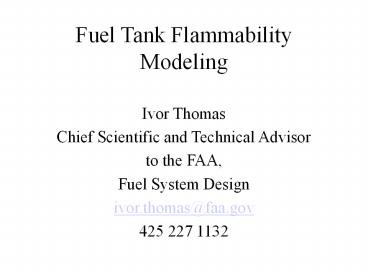Fuel Tank Flammability Modeling PowerPoint PPT Presentation
Title: Fuel Tank Flammability Modeling
1
Fuel Tank Flammability Modeling
- Ivor Thomas
- Chief Scientific and Technical Advisor
- to the FAA,
- Fuel System Design
- ivor.thomas_at_faa.gov
- 425 227 1132
2
Agenda
- Concept
- Approach
- Assumptions
- Results
- Questions
3
Initial Problem
- Need To be able to assess flammability in
airplane fuel tanks so that safety enhancements
could be assessed against each other. - Problem Flights all over the world create widely
varying conditions and times when a tank may be
flammable, but FAA needed to assess the overall
safety benefits of an enhancement
4
Concept
- Create a computer model to
- Assess tank flammability for a large number of
flights throughout the world, - Assess the impact of any enhancements on reducing
overall flammability, - look at risks in specific conditions,
- (and make it simple enough to run quickly).
5
Approach
- Monte Carlo technique to create several thousand
flights in worldwide atmospheric conditions with
critical variables such as flash point of the
fuel also varying to represent the real world. - This approach required several sub-models
- The airplane performance
- The tank thermal response
- The atmosphere
- The fuel
- The system enhancement proposed
6
Monte Carlo Analysis
- Technique to allow a statistical analysis of a
problem with a number of independent variables - Technique uses known distribution probabilities
for variables and runs 1000s of cases with
randomly selected values for each variable in
each case. - End result is a overall average but doesnt look
at specific risk on any one case.
7
Airplane Performance
- A simple airplane performance model was developed
to allow various airplanes to be studied, which
included - Time on the ground
- Fuel load
- Climb Time/Speed schedule
- Cruise Alt. And Mn. including step climbs on
longer flights - Descent and Landing Time/Speed schedule in
Descent - Mission Length Distribution
8
(No Transcript)
9
(No Transcript)
10
Tank Thermal Response
- Tank treated as simple object with thermal
response characteristics determined from separate
thermal modeling or flight test. - Characteristics defined by
- Exponential time constant for full and empty
conditions both ground and flight - Equilibrium temperature the tank would reach
(given enough time) relative to total air
temperature for both ground and flight
11
(No Transcript)
12
Atmospheric model
- Any flight uses two inputs,
- Ground ambient, and
- Ambient temperature above the Tropopause.
- For any given flight, the two values are picked
randomly to match the known world temperature
distribution
13
(No Transcript)
14
Atmospheric model
- The Temperature Profile versus Altitude is the
determined, using a standard lapse rate to the
tropopause, and constant above, with a
temperature inversion effect if the ground
ambient is below 00 F.
15
(No Transcript)
16
(No Transcript)
17
Fuel Variability and Flammability
- The FAA has surveyed the fuels being used by the
fleet and determined the flash point range and
distribution, - Fuel Air Ratio at the Flash Point has been
measured for a number of these fuels, and this
has been used to correlate Flammability range to
Flash Point
18
(No Transcript)
19
(No Transcript)
20
Flammability Assessment
- An Computer model was created to integrate all
the factors discussed to predict fuel tank
flammability - Model can run one flight to look at specific
risk, or - Model can run several thousand flights to
determine fleet average fuel tank flammability
exposure.
21
(No Transcript)
22
(No Transcript)
23
(No Transcript)
24
Potential Mitigating Effects
- The model can be used to assess mitigating
systems - Reduced heat flow to the tank
- Increased heat flow out of the tank
- Fuel Tank Inerting
- Ground Only
- In-flight
- In-Flight with limitations (e.g. Low nitrogen
flow in Descent)
25
(No Transcript)
26
Conclusions
- The Flammability Exposure model has given the FAA
and industry a common tool to assess fuel tank
flammability and to evaluate potential mitigating
actions.
27
Open Issues
- Flammability limits with altitude and with
various levels of Nitrogen in the ullage - FAA testing in progress
- Flammability Limits with very low fuel quantities
and time dependent effects of non-equilibrium
conditions - FAA /Rutgers University work in progress
28
Questions??

